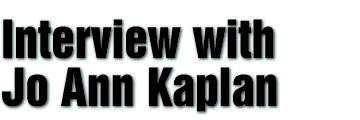|
|||||
|
Jo Ann Kaplan has been trained in fine arts in New York in the mid-sixties, when a lot of people in arts schools were becoming interested in film, possibly because conventional painting and sculture was dead. "We all started making movies like Andy Warhol did, because nobody had any notion of montage. To simply put the camera in front of anything was interesting. Warhol to us was somebody who was making cheap films and in a sort of art context. There was an element of narrative and characterization, however bizarre, and a style - real time and static camera - that was also interesting. Besides, it was easy to get a 16mm camera and shoot something incredibly cheap." Kaplan always felt her background as a tension between an art background and certain aspects of conventional cinema. "I like going into a cinema and walking into a story," she says, "and I find a lot of difficulties with looking at structuralist films because I do not find something with which I can emotionally engage. I had already seen a lot of North-American structural work, like Michael Snow. I found it difficult to place myself in relation to them." When she left America her context changed. She first went to Paris and spent day and night at the Cinematheque, "a place where in a day you could see Hollywood B-movies, a Dreyer film, a Fritz Lang serial with Czech subtitles, everything they had in their archive was shown. It seemed to encourage a kind of eclecticism or to expose to all kinds of work." After a period in Paris she began to meet London International Film School graduates and "realised that there was an industry out there." A talent for editing got her foot in the door and she made another crucial discovery; that unlike in America, there was state funding to be had. She then spent seven years developing her editing skills and less hard-headedly writing and researching a film with "no real probability of being made". Nevertheless, whilst her ambitions to make "a big movie" seemed unlikely to be realised, there did seem to be a possibility of getting some kind of budget. In the late seventies, she became involved with the many women starting to make television programmes and films, and completed her first television project with Arts Council funding in 1986. Its subject was Maya Deren, reflecting her continuing interest in Art and narrative. She describes it as more biography than Art history, exploring aspects of Deren beyong the artistic, such as her involvement with voodoo. "I had ambitions of making a big movie but I had no notion about the reality of how you go about doing this. At the same time I began to see that if I worked as an editor not only would I earn a decent living but I would learn skills and meet people, but I could find a way to make films with at least some budget. Story of I developed from a "kind of obsession with erotic pictures". However, despite frustrating attempts at self-censorship, the material was obviously too hot for television. Underlining the ubiquity of sex and the woman's point of view in the media" I clearly tapped an interest" she was therefore forced to treat the material in an artistic rather than journalistic way. Bataille's surrealist novel provided a "narrative hanger", describing the erotic adventures of a sixteen year-old boy; "somebody's sexual education". Kaplan's reticence about gender - "I always feel uncomfortable in making a statement about myself as a woman"- did not blind her to the curious situation of "a woman reading a man's text and placing herself in it". Although the book is written from the male adolescent's point of view, she had responded strongly to it, expressing this intensity in the film by placing a woman "in the most exposed and intimate circumstances you can imagine"; naked in a bath whilst reading the book. "A
woman's voice saying 'my cock' is somehow very
disturbing, because it is discontinuous, it doesn't make
any sense. But I found that very exciting."
... Full article published in Filmwaves - Issue 2, November 1997. Subscribe now! |

